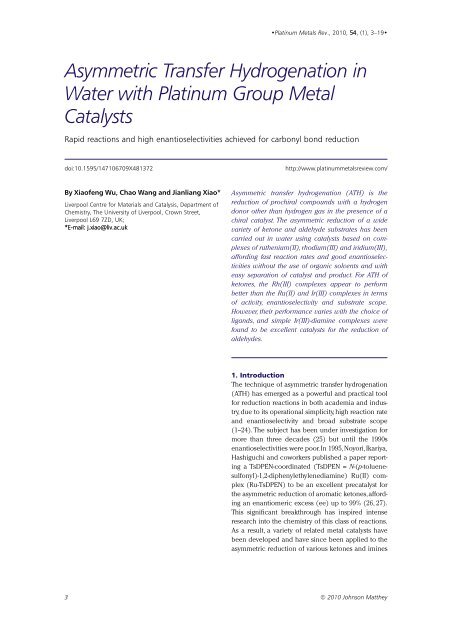Download Issue PDF - Platinum Metals Review
Download Issue PDF - Platinum Metals Review
Download Issue PDF - Platinum Metals Review
You also want an ePaper? Increase the reach of your titles
YUMPU automatically turns print PDFs into web optimized ePapers that Google loves.
•<strong>Platinum</strong> <strong>Metals</strong> Rev., 2010, 54, (1), 3–19•<br />
Asymmetric Transfer Hydrogenation in<br />
Water with <strong>Platinum</strong> Group Metal<br />
Catalysts<br />
Rapid reactions and high enantioselectivities achieved for carbonyl bond reduction<br />
doi:10.1595/147106709X481372<br />
http://www.platinummetalsreview.com/<br />
By Xiaofeng Wu, Chao Wang and Jianliang Xiao*<br />
Liverpool Centre for Materials and Catalysis, Department of<br />
Chemistry, The University of Liverpool, Crown Street,<br />
Liverpool L69 7ZD, UK;<br />
*E-mail: j.xiao@liv.ac.uk<br />
Asymmetric transfer hydrogenation (ATH) is the<br />
reduction of prochiral compounds with a hydrogen<br />
donor other than hydrogen gas in the presence of a<br />
chiral catalyst. The asymmetric reduction of a wide<br />
variety of ketone and aldehyde substrates has been<br />
carried out in water using catalysts based on complexes<br />
of ruthenium(II),rhodium(III) and iridium(III),<br />
affording fast reaction rates and good enantioselectivities<br />
without the use of organic solvents and with<br />
easy separation of catalyst and product. For ATH of<br />
ketones, the Rh(III) complexes appear to perform<br />
better than the Ru(II) and Ir(III) complexes in terms<br />
of activity, enantioselectivity and substrate scope.<br />
However, their performance varies with the choice of<br />
ligands, and simple Ir(III)-diamine complexes were<br />
found to be excellent catalysts for the reduction of<br />
aldehydes.<br />
1. Introduction<br />
The technique of asymmetric transfer hydrogenation<br />
(ATH) has emerged as a powerful and practical tool<br />
for reduction reactions in both academia and industry,<br />
due to its operational simplicity, high reaction rate<br />
and enantioselectivity and broad substrate scope<br />
(1–24). The subject has been under investigation for<br />
more than three decades (25) but until the 1990s<br />
enantioselectivities were poor.In 1995,Noyori,Ikariya,<br />
Hashiguchi and coworkers published a paper reporting<br />
a TsDPEN-coordinated (TsDPEN = N-(p-toluenesulfonyl)-1,2-diphenylethylenediamine)<br />
Ru(II) complex<br />
(Ru-TsDPEN) to be an excellent precatalyst for<br />
the asymmetric reduction of aromatic ketones,affording<br />
an enantiomeric excess (ee) up to 99% (26, 27).<br />
This significant breakthrough has inspired intense<br />
research into the chemistry of this class of reactions.<br />
As a result, a variety of related metal catalysts have<br />
been developed and have since been applied to the<br />
asymmetric reduction of various ketones and imines<br />
3 © 2010 Johnson Matthey
















